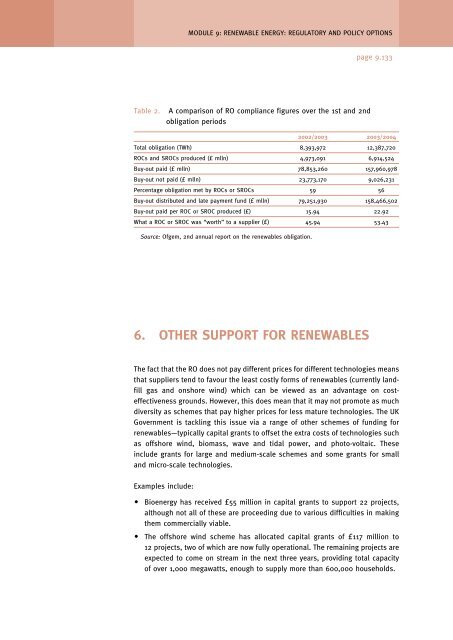Regulatory and policy options to encourage development of ...
Regulatory and policy options to encourage development of ...
Regulatory and policy options to encourage development of ...
- No tags were found...
Create successful ePaper yourself
Turn your PDF publications into a flip-book with our unique Google optimized e-Paper software.
MODULE 9: RENEWABLE ENERGY: REGULATORY AND POLICY OPTIONSpage 9.133Table 2.A comparison <strong>of</strong> RO compliance figures over the 1st <strong>and</strong> 2ndobligation periods2002/2003 2003/2004Total obligation (TWh) 8,393,972 12,387,720ROCs <strong>and</strong> SROCs produced (£ mlln) 4,973,091 6,914,524Buy-out paid (£ mlln) 78,853,260 157,960,978Buy-out not paid (£ mlln) 23,773,170 9,026,231Percentage obligation met by ROCs or SROCs 59 56Buy-out distributed <strong>and</strong> late payment fund (£ mlln) 79,251,930 158,466,502Buy-out paid per ROC or SROC produced (£) 15.94 22.92What a ROC or SROC was “worth” <strong>to</strong> a supplier (£) 45.94 53.43Source: Ofgem, 2nd annual report on the renewables obligation.6. OTHER SUPPORT FOR RENEWABLESThe fact that the RO does not pay different prices for different technologies meansthat suppliers tend <strong>to</strong> favour the least costly forms <strong>of</strong> renewables (currently l<strong>and</strong>fillgas <strong>and</strong> onshore wind) which can be viewed as an advantage on costeffectivenessgrounds. However, this does mean that it may not promote as muchdiversity as schemes that pay higher prices for less mature technologies. The UKGovernment is tackling this issue via a range <strong>of</strong> other schemes <strong>of</strong> funding forrenewables—typically capital grants <strong>to</strong> <strong>of</strong>fset the extra costs <strong>of</strong> technologies suchas <strong>of</strong>fshore wind, biomass, wave <strong>and</strong> tidal power, <strong>and</strong> pho<strong>to</strong>-voltaic. Theseinclude grants for large <strong>and</strong> medium-scale schemes <strong>and</strong> some grants for small<strong>and</strong> micro-scale technologies.Examples include: Bioenergy has received £55 million in capital grants <strong>to</strong> support 22 projects,although not all <strong>of</strong> these are proceeding due <strong>to</strong> various difficulties in makingthem commercially viable. The <strong>of</strong>fshore wind scheme has allocated capital grants <strong>of</strong> £117 million <strong>to</strong>12 projects, two <strong>of</strong> which are now fully operational. The remaining projects areexpected <strong>to</strong> come on stream in the next three years, providing <strong>to</strong>tal capacity<strong>of</strong> over 1,000 megawatts, enough <strong>to</strong> supply more than 600,000 households.










